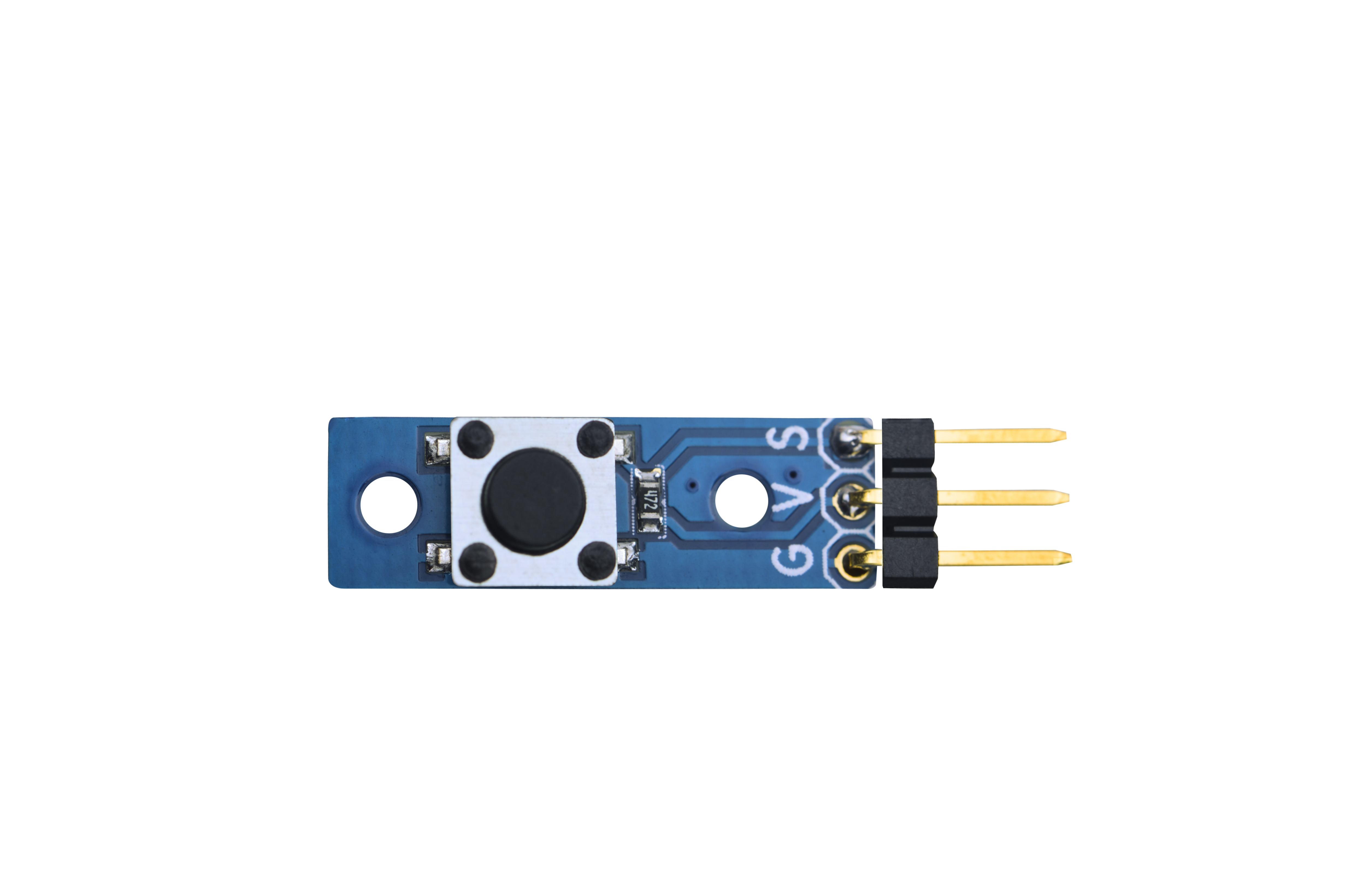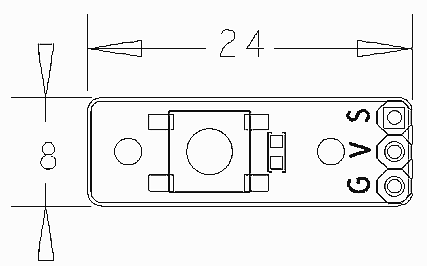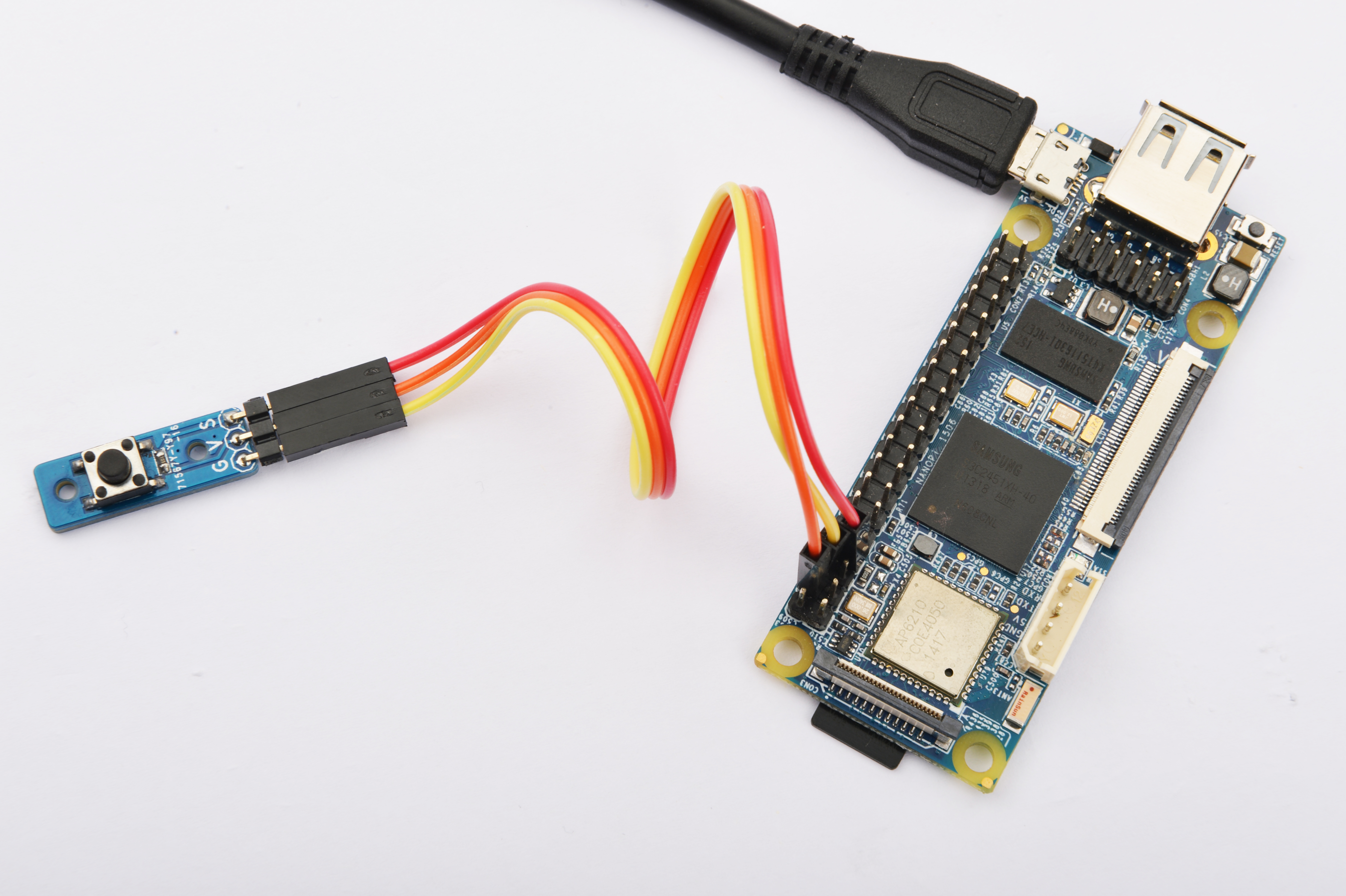Difference between revisions of "Matrix - Button"
(→Download Matrix Source Code) |
|||
| Line 1: | Line 1: | ||
| − | [[Matrix - Button | + | [[Matrix - Button|English]] |
| − | + | ==介绍== | |
| − | == | + | |
[[File:Btn01.jpg|thumb|按键]] | [[File:Btn01.jpg|thumb|按键]] | ||
| − | * | + | * 模块Matrix-Button用于检测按键事件。 |
| − | * | + | * 未按时输出高电平,按下后输出低电平。 |
| − | == | + | ==特性== |
| − | * | + | * 使用标准的3 PIN接口 |
| − | * | + | * 尺寸为 8x24mm |
| + | * PCB尺寸(mm):8x24 | ||
[[File:btn002.png | frameless|400px|BTN-01.PCB]] | [[File:btn002.png | frameless|400px|BTN-01.PCB]] | ||
| − | * | + | * 引脚说明: |
{| class="wikitable" | {| class="wikitable" | ||
|- | |- | ||
| − | | | + | |名称 || 描述 |
|- | |- | ||
|S || GPIO | |S || GPIO | ||
|- | |- | ||
| − | |V || | + | |V || 电源5V |
|- | |- | ||
| − | |G || | + | |G || 地 |
|} | |} | ||
| − | == | + | ==工作原理== |
| − | * | + | * Matrix-Button主要器件是一个瞬时(非自锁)按钮开关,通过3-Pin 2.54mm排针中的S信号输出按钮开关的状态。 |
| − | * | + | * 平时没有按下按钮时触点断开,S输出高电平;当按下按钮时触点导通,S输出低电平,直到松开才恢复高电平。 |
| − | == | + | ==下载Matrix源码== |
| − | + | Matrix配件相关的代码是完全开源的,统一由一个仓库进行管理:https://github.com/friendlyarm/matrix.git <br> | |
| − | + | 该仓库里不同的分支代表着Matrix配件所支持的不同开发板。<br> | |
| − | * | + | * nanopi分支用于支持NanoPi; |
| − | * | + | * nanopi2分支用于支持NanoPi 2; |
| − | * | + | * tiny4412分支用于支持Tiny4412; |
| + | * raspberrypi分支用于支持RaspberryPi; | ||
| − | + | 在主机PC上安装git,以Ubuntu14.04为例 | |
| − | + | ||
<syntaxhighlight lang="bash"> | <syntaxhighlight lang="bash"> | ||
$ sudo apt-get install git | $ sudo apt-get install git | ||
</syntaxhighlight> | </syntaxhighlight> | ||
| − | + | 克隆Matrix配件代码仓库 | |
<syntaxhighlight lang="bash"> | <syntaxhighlight lang="bash"> | ||
$ git clone https://github.com/friendlyarm/matrix.git | $ git clone https://github.com/friendlyarm/matrix.git | ||
</syntaxhighlight> | </syntaxhighlight> | ||
| − | + | 克隆完成后会得到一个名为matrix的目录,里面存放着所有Matrix配件的代码。 | |
| − | == | + | ==与NanoPi 2连接使用== |
| − | === | + | ===硬件连接=== |
| − | + | 参考下图连接模块Matrix-Button和NanoPi 2:<br> | |
[[File:Matrix-Button_nanopi_2.jpg|frameless|600px|Matrix-Button_nanopi_2]] | [[File:Matrix-Button_nanopi_2.jpg|frameless|600px|Matrix-Button_nanopi_2]] | ||
| − | + | 连接说明: | |
{| class="wikitable" | {| class="wikitable" | ||
|- | |- | ||
| Line 62: | Line 62: | ||
|G || Pin6 | |G || Pin6 | ||
|} | |} | ||
| − | === | + | ===编译测试程序=== |
| − | + | 进入Matrix代码仓库,切换到nanopi2分支 | |
<syntaxhighlight lang="bash"> | <syntaxhighlight lang="bash"> | ||
$ cd matrix | $ cd matrix | ||
| Line 69: | Line 69: | ||
</syntaxhighlight> | </syntaxhighlight> | ||
| − | + | 编译Matrix配件代码 | |
<syntaxhighlight lang="bash"> | <syntaxhighlight lang="bash"> | ||
$ make CROSS_COMPILE=arm-linux- clean | $ make CROSS_COMPILE=arm-linux- clean | ||
| Line 75: | Line 75: | ||
$ make CROSS_COMPILE=arm-linux- install | $ make CROSS_COMPILE=arm-linux- install | ||
</syntaxhighlight> | </syntaxhighlight> | ||
| − | + | 注意:请确保你的主机PC当前使用的交叉编译器为NanoPi 2配套的arm-linux-gcc-4.9.3。<br> | |
| − | + | 编译成功后库文件位于install/lib目录下,而测试程序则位于install/usr/bin目录下,模块Matrix-Button对应的测试程序为matrix-button。<br> | |
| − | === | + | ===运行测试程序=== |
| − | + | 将带有Debian系统的SD卡插入一台运行Linux的电脑,可以挂载SD卡上的boot和rootfs分区。<br> | |
| − | + | 假设rootfs分区的挂载路径为/media/rootfs,执行以下命令将Matrix的硬件驱动、库文件和测试程序拷贝到NanoPi 2的文件系统上。<br> | |
<syntaxhighlight lang="bash"> | <syntaxhighlight lang="bash"> | ||
$ cp modules /media/rootfs/ -r | $ cp modules /media/rootfs/ -r | ||
| Line 87: | Line 87: | ||
</syntaxhighlight> | </syntaxhighlight> | ||
| − | + | 将SD卡重新插入NanoPi 2,上电启动,在Debian的shell终端中执行以下命令加载硬件驱动。<br> | |
<syntaxhighlight lang="bash"> | <syntaxhighlight lang="bash"> | ||
$ cd /modules | $ cd /modules | ||
| Line 93: | Line 93: | ||
</syntaxhighlight> | </syntaxhighlight> | ||
| − | + | 运行模块Matrix-Button的测试程序。<br> | |
<syntaxhighlight lang="bash"> | <syntaxhighlight lang="bash"> | ||
$ matrix-button | $ matrix-button | ||
</syntaxhighlight> | </syntaxhighlight> | ||
| − | + | 运行效果如下:<br> | |
[[File:matrix-button_result.png|frameless|600px|matrix-button_result]] | [[File:matrix-button_result.png|frameless|600px|matrix-button_result]] | ||
| − | === | + | ===代码展示=== |
<syntaxhighlight lang="c"> | <syntaxhighlight lang="c"> | ||
static struct sensor button[] = { | static struct sensor button[] = { | ||
| Line 140: | Line 140: | ||
</syntaxhighlight> | </syntaxhighlight> | ||
| − | == | + | ==与NanoPi连接使用== |
| − | === | + | ===准备工作=== |
| − | + | 在NanoPi上运行Debian系统,然后在主机PC上安装并使用相应的编译器,参考wiki: [[NanoPi/zh|NanoPi]] & [[How_to_build_the_Compiling_Environment/zh|How to Build the Compiling Environment]]。<br> | |
| − | + | 注意: 只有使用nanopi-v4.1.y-matrix分支编译出来的内核才能配合Matrix配件正常工作。<br> | |
| + | 下载NanoPi内核源代码并编译: <br> | ||
<syntaxhighlight lang="bash"> | <syntaxhighlight lang="bash"> | ||
$ git clone https://github.com/friendlyarm/linux-4.x.y.git | $ git clone https://github.com/friendlyarm/linux-4.x.y.git | ||
| Line 152: | Line 153: | ||
$ make | $ make | ||
</syntaxhighlight> | </syntaxhighlight> | ||
| − | + | 编译好后的zImage位于内核源码arch/arm/boot/目录下,把该zImage替换掉NanoPi烧写文件sd-fuse_nanopi/prebuilt下的zImage,重新制作SD卡即可。 | |
| − | === | + | ===硬件连接=== |
| − | + | 参考下图连接模块Matrix-Button和NanoPi:<br> | |
[[File:matrix-button_nanopi.jpg|frameless|600px|matrix-button_nanopi]] | [[File:matrix-button_nanopi.jpg|frameless|600px|matrix-button_nanopi]] | ||
| − | + | 连接说明: | |
{| class="wikitable" | {| class="wikitable" | ||
|- | |- | ||
| Line 165: | Line 166: | ||
|S || Pin7 | |S || Pin7 | ||
|- | |- | ||
| − | |V | + | |V || Pin4 |
|- | |- | ||
| − | |G | + | |G || Pin6 |
|} | |} | ||
| − | === | + | ===编译测试程序=== |
| − | + | 进入Matrix代码仓库,切换到nanopi分支 | |
<syntaxhighlight lang="bash"> | <syntaxhighlight lang="bash"> | ||
$ cd matrix | $ cd matrix | ||
| Line 177: | Line 178: | ||
</syntaxhighlight> | </syntaxhighlight> | ||
| − | + | 编译Matrix配件代码 | |
<syntaxhighlight lang="bash"> | <syntaxhighlight lang="bash"> | ||
$ make CROSS_COMPILE=arm-linux- clean | $ make CROSS_COMPILE=arm-linux- clean | ||
| Line 183: | Line 184: | ||
$ make CROSS_COMPILE=arm-linux- install | $ make CROSS_COMPILE=arm-linux- install | ||
</syntaxhighlight> | </syntaxhighlight> | ||
| − | + | 注意:请确保你的主机PC当前使用的交叉编译器为NanoPi-Debian配套的arm-linux-gcc-4.4.3。<br> | |
| − | + | 编译出来的库文件位于install/lib目录下,而测试程序则位于install/usr/bin目录下,模块Matrix-Button对应的测试程序为matrix-button。<br> | |
| − | === | + | ===运行测试程序=== |
| − | + | 将带有Debian系统的SD卡插入一台运行Linux的电脑,可以挂载SD卡上的boot和rootfs分区。<br> | |
| − | + | 假设rootfs分区的挂载路径为/media/rootfs,执行以下命令可将Matrix的所有库文件和测试程序拷贝到NanoPi的文件系统上。<br> | |
<syntaxhighlight lang="bash"> | <syntaxhighlight lang="bash"> | ||
| − | |||
$ cp install/usr/bin/* /media/rootfs/usr/bin/ | $ cp install/usr/bin/* /media/rootfs/usr/bin/ | ||
| + | $ cp install/lib/* /media/rootfs/lib/ -d | ||
</syntaxhighlight> | </syntaxhighlight> | ||
| − | + | 将SD卡重新插入NanoPi,上电启动,在Debian的shell终端中执行以下命令运行模块Matrix-Button的测试程序。<br> | |
<syntaxhighlight lang="bash"> | <syntaxhighlight lang="bash"> | ||
$ matrix-button | $ matrix-button | ||
</syntaxhighlight> | </syntaxhighlight> | ||
| + | 注意:此模块并不支持热插拔,启动系统前需要确保硬件正常连接。 | ||
| − | === | + | ===代码展示=== |
<syntaxhighlight lang="c"> | <syntaxhighlight lang="c"> | ||
int main(int argc, char ** argv) | int main(int argc, char ** argv) | ||
| Line 228: | Line 230: | ||
</syntaxhighlight> | </syntaxhighlight> | ||
| − | == | + | ==与Tiny4412连接使用== |
| − | === | + | ===准备工作=== |
| − | + | 参考Tiny4412光盘里的《友善之臂Ubuntu使用手册》,在Tiny4412上运行UbuntuCore系统,然后在主机PC上安装并使用相应的编译器。<br> | |
| − | + | 注意:只能使用Tiny4412SDK-1506的底板。 | |
| − | === | + | ===硬件连接=== |
| − | + | 参考下图连接模块Matrix-Button和Tiny4412 <br> | |
[[File:matrix-button_tiny4412.jpg|frameless|600px|matrix-button_tiny4412]] | [[File:matrix-button_tiny4412.jpg|frameless|600px|matrix-button_tiny4412]] | ||
| − | + | 连接说明: | |
{| class="wikitable" | {| class="wikitable" | ||
|- | |- | ||
| Line 249: | Line 251: | ||
|} | |} | ||
| − | === | + | ===编译测试程序=== |
| − | + | 进入Matrix代码仓库,切换到tiny4412分支 | |
<syntaxhighlight lang="bash"> | <syntaxhighlight lang="bash"> | ||
$ cd matrix | $ cd matrix | ||
| Line 256: | Line 258: | ||
</syntaxhighlight> | </syntaxhighlight> | ||
| − | + | 编译Matrix配件代码 | |
<syntaxhighlight lang="bash"> | <syntaxhighlight lang="bash"> | ||
$ make CROSS_COMPILE=arm-linux-gnueabihf- clean | $ make CROSS_COMPILE=arm-linux-gnueabihf- clean | ||
| Line 262: | Line 264: | ||
$ make CROSS_COMPILE=arm-linux-gnueabihf- install | $ make CROSS_COMPILE=arm-linux-gnueabihf- install | ||
</syntaxhighlight> | </syntaxhighlight> | ||
| − | + | 注意:请确保你的主机PC当前使用的交叉编译器为Tiny4412-UbuntuCore配套的arm-linux-gnueabihf-gcc-4.7.3。<br> | |
| − | + | 编译出来的库文件位于install/lib目录下,而测试程序则位于install/usr/bin目录下,模块Matrix-Button对应的测试程序为matrix-button。 | |
| − | === | + | ===运行测试程序=== |
| − | + | 将带有UbuntuCore系统的SD卡插入一台运行Linux的电脑,可以挂载SD卡上的boot和rootfs分区。<br> | |
| − | + | 假设rootfs分区的挂载路径为/media/rootfs,执行以下命令可将Matrix的所有库文件和测试程序拷贝到Tiny4412的文件系统上。<br> | |
<syntaxhighlight lang="bash"> | <syntaxhighlight lang="bash"> | ||
$ cp install/usr/bin/* /media/rootfs/usr/bin/ | $ cp install/usr/bin/* /media/rootfs/usr/bin/ | ||
| Line 273: | Line 275: | ||
</syntaxhighlight> | </syntaxhighlight> | ||
| − | + | 将SD卡重新插入Tiny4412,上电启动,在UbuntuCore的shell终端中执行以下命令运行模块Matrix-Button的测试程序。<br> | |
<syntaxhighlight lang="bash"> | <syntaxhighlight lang="bash"> | ||
$ matrix-button | $ matrix-button | ||
</syntaxhighlight> | </syntaxhighlight> | ||
| − | + | 注意:此模块并不支持热插拔,启动系统前需要确保硬件连接正确。 | |
| − | === | + | ===代码展示=== |
<syntaxhighlight lang="c"> | <syntaxhighlight lang="c"> | ||
int main(int argc, char ** argv) | int main(int argc, char ** argv) | ||
| Line 287: | Line 289: | ||
char value[ARRAY_SIZE(button)]; | char value[ARRAY_SIZE(button)]; | ||
int devFD = -1; | int devFD = -1; | ||
| − | + | ||
printf("Using pin GPIO_PIN1\n"); | printf("Using pin GPIO_PIN1\n"); | ||
if ((devFD =sensorInit(button, ARRAY_SIZE(button))) == -1) { | if ((devFD =sensorInit(button, ARRAY_SIZE(button))) == -1) { | ||
| Line 308: | Line 310: | ||
</syntaxhighlight> | </syntaxhighlight> | ||
| − | == | + | ==与RaspberryPi连接使用== |
| − | + | ||
| − | + | ||
| − | + | ||
| − | + | ||
| − | + | ||
| − | + | ||
| − | + | ||
| − | + | ||
| − | + | ||
| − | + | ||
| − | + | ||
| − | + | ||
| − | + | ||
| − | + | ||
| − | + | ||
| − | + | ||
| − | + | ||
| − | + | ||
| − | + | ||
| − | + | ||
| − | + | ||
| − | + | ||
| − | + | ||
| − | + | ||
| − | + | ||
| − | + | ||
| − | + | ||
| − | + | ||
| − | + | ||
| − | + | ||
| − | + | ||
| − | + | ||
| − | + | ||
| − | + | ||
| − | + | ||
| − | + | ||
| − | + | ||
| − | + | ||
| − | + | ||
| − | + | ||
| − | + | ||
| − | + | ||
| − | + | ||
| − | + | ||
| − | + | ||
| − | + | ||
| − | + | ||
| − | + | ||
| − | + | ||
| − | + | ||
| − | + | ||
| − | + | ||
| − | + | ||
| − | + | ||
| − | + | ||
| − | + | ||
| − | + | ||
| − | + | ||
| − | + | ||
| − | + | ||
| − | + | ||
| − | + | ||
| − | + | ||
| − | + | ||
| − | + | ||
| − | + | ||
| − | + | ||
| − | + | ||
| − | == | + | ==与Arduino连接使用== |
| − | + | ==相关资料== | |
Revision as of 10:15, 28 December 2015
English
Contents
1 介绍
- 模块Matrix-Button用于检测按键事件。
- 未按时输出高电平,按下后输出低电平。
2 特性
- 使用标准的3 PIN接口
- 尺寸为 8x24mm
- PCB尺寸(mm):8x24
- 引脚说明:
| 名称 | 描述 |
| S | GPIO |
| V | 电源5V |
| G | 地 |
3 工作原理
- Matrix-Button主要器件是一个瞬时(非自锁)按钮开关,通过3-Pin 2.54mm排针中的S信号输出按钮开关的状态。
- 平时没有按下按钮时触点断开,S输出高电平;当按下按钮时触点导通,S输出低电平,直到松开才恢复高电平。
4 下载Matrix源码
Matrix配件相关的代码是完全开源的,统一由一个仓库进行管理:https://github.com/friendlyarm/matrix.git
该仓库里不同的分支代表着Matrix配件所支持的不同开发板。
- nanopi分支用于支持NanoPi;
- nanopi2分支用于支持NanoPi 2;
- tiny4412分支用于支持Tiny4412;
- raspberrypi分支用于支持RaspberryPi;
在主机PC上安装git,以Ubuntu14.04为例
$ sudo apt-get install git
克隆Matrix配件代码仓库
$ git clone https://github.com/friendlyarm/matrix.git
克隆完成后会得到一个名为matrix的目录,里面存放着所有Matrix配件的代码。
5 与NanoPi 2连接使用
5.1 硬件连接
参考下图连接模块Matrix-Button和NanoPi 2:
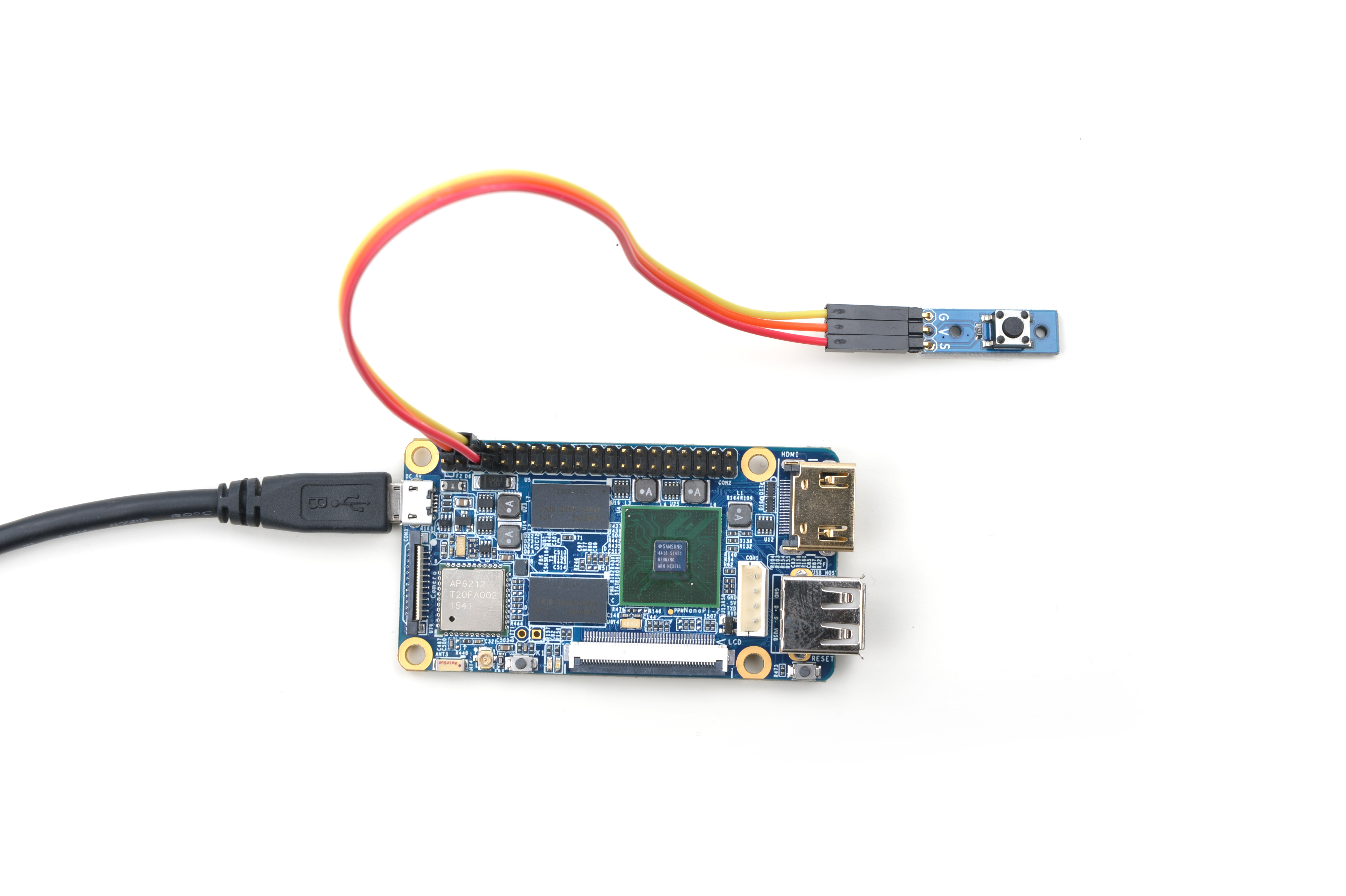
连接说明:
| Matrix-Button | NanoPi 2 |
| S | Pin7 |
| V | Pin4 |
| G | Pin6 |
5.2 编译测试程序
进入Matrix代码仓库,切换到nanopi2分支
$ cd matrix $ git checkout nanopi2
编译Matrix配件代码
$ make CROSS_COMPILE=arm-linux- clean $ make CROSS_COMPILE=arm-linux- $ make CROSS_COMPILE=arm-linux- install
注意:请确保你的主机PC当前使用的交叉编译器为NanoPi 2配套的arm-linux-gcc-4.9.3。
编译成功后库文件位于install/lib目录下,而测试程序则位于install/usr/bin目录下,模块Matrix-Button对应的测试程序为matrix-button。
5.3 运行测试程序
将带有Debian系统的SD卡插入一台运行Linux的电脑,可以挂载SD卡上的boot和rootfs分区。
假设rootfs分区的挂载路径为/media/rootfs,执行以下命令将Matrix的硬件驱动、库文件和测试程序拷贝到NanoPi 2的文件系统上。
$ cp modules /media/rootfs/ -r $ cp install/lib/* /media/rootfs/lib/ -d $ cp install/usr/bin/* /media/rootfs/usr/bin/
将SD卡重新插入NanoPi 2,上电启动,在Debian的shell终端中执行以下命令加载硬件驱动。
$ cd /modules $ insmod matrix_gpio_int.ko
运行模块Matrix-Button的测试程序。
$ matrix-button5.4 代码展示
static struct sensor button[] = { { GPIO_PIN(7), IRQ_TYPE_EDGE_FALLING, } }; int main(int argc, char ** argv) { int i; int retSize = -1; char value[ARRAY_SIZE(button)]; int devFD = -1; if (argc == 2) { button[0].pin = atoi(argv[1]); } printf("Using GPIO_PIN(%d)\n", button[0].pin); if ((devFD =sensorInit(button, ARRAY_SIZE(button))) == -1) { printf("Fail to init sensor\n"); return -1; } printf("Press the button...\n"); if ((retSize = sensorRead(devFD, value, ARRAY_SIZE(button))) == -1) { printf("Fail to read sensors\n"); } if (retSize > 0) { i = 0; for (i=0; i<retSize; i++) { printf("Button[%d]:%d\n", i, value[i]); } } sensorDeinit(devFD); return 0; }
6 与NanoPi连接使用
6.1 准备工作
在NanoPi上运行Debian系统,然后在主机PC上安装并使用相应的编译器,参考wiki: NanoPi & How to Build the Compiling Environment。
注意: 只有使用nanopi-v4.1.y-matrix分支编译出来的内核才能配合Matrix配件正常工作。
下载NanoPi内核源代码并编译:
$ git clone https://github.com/friendlyarm/linux-4.x.y.git $ cd linux-4.x.y $ git checkout nanopi-v4.1.y-matrix $ make nanopi_defconfig $ touch .scmversion $ make
编译好后的zImage位于内核源码arch/arm/boot/目录下,把该zImage替换掉NanoPi烧写文件sd-fuse_nanopi/prebuilt下的zImage,重新制作SD卡即可。
6.2 硬件连接
连接说明:
| Matrix-Button | NanoPi |
| S | Pin7 |
| V | Pin4 |
| G | Pin6 |
6.3 编译测试程序
进入Matrix代码仓库,切换到nanopi分支
$ cd matrix $ git checkout nanopi
编译Matrix配件代码
$ make CROSS_COMPILE=arm-linux- clean $ make CROSS_COMPILE=arm-linux- $ make CROSS_COMPILE=arm-linux- install
注意:请确保你的主机PC当前使用的交叉编译器为NanoPi-Debian配套的arm-linux-gcc-4.4.3。
编译出来的库文件位于install/lib目录下,而测试程序则位于install/usr/bin目录下,模块Matrix-Button对应的测试程序为matrix-button。
6.4 运行测试程序
将带有Debian系统的SD卡插入一台运行Linux的电脑,可以挂载SD卡上的boot和rootfs分区。
假设rootfs分区的挂载路径为/media/rootfs,执行以下命令可将Matrix的所有库文件和测试程序拷贝到NanoPi的文件系统上。
$ cp install/usr/bin/* /media/rootfs/usr/bin/ $ cp install/lib/* /media/rootfs/lib/ -d
将SD卡重新插入NanoPi,上电启动,在Debian的shell终端中执行以下命令运行模块Matrix-Button的测试程序。
$ matrix-button注意:此模块并不支持热插拔,启动系统前需要确保硬件正常连接。
6.5 代码展示
int main(int argc, char ** argv) { int i; int retSize = -1; char value[ARRAY_SIZE(button)]; int devFD = -1; printf("Using pin GPIO_PIN1\n"); if ((devFD =sensorInit(button, ARRAY_SIZE(button))) == -1) { printf("Fail to init sensor\n"); return -1; } printf("Press the button...\n"); if ((retSize = sensorRead(devFD, value, ARRAY_SIZE(button))) == -1) { printf("Fail to read sensors\n"); } if (retSize > 0) { i = 0; for (i=0; i<retSize; i++) { printf("Button[%d]:%d\n", i, value[i]); } } sensorDeinit(devFD); return 0; }
7 与Tiny4412连接使用
7.1 准备工作
参考Tiny4412光盘里的《友善之臂Ubuntu使用手册》,在Tiny4412上运行UbuntuCore系统,然后在主机PC上安装并使用相应的编译器。
注意:只能使用Tiny4412SDK-1506的底板。
7.2 硬件连接
参考下图连接模块Matrix-Button和Tiny4412
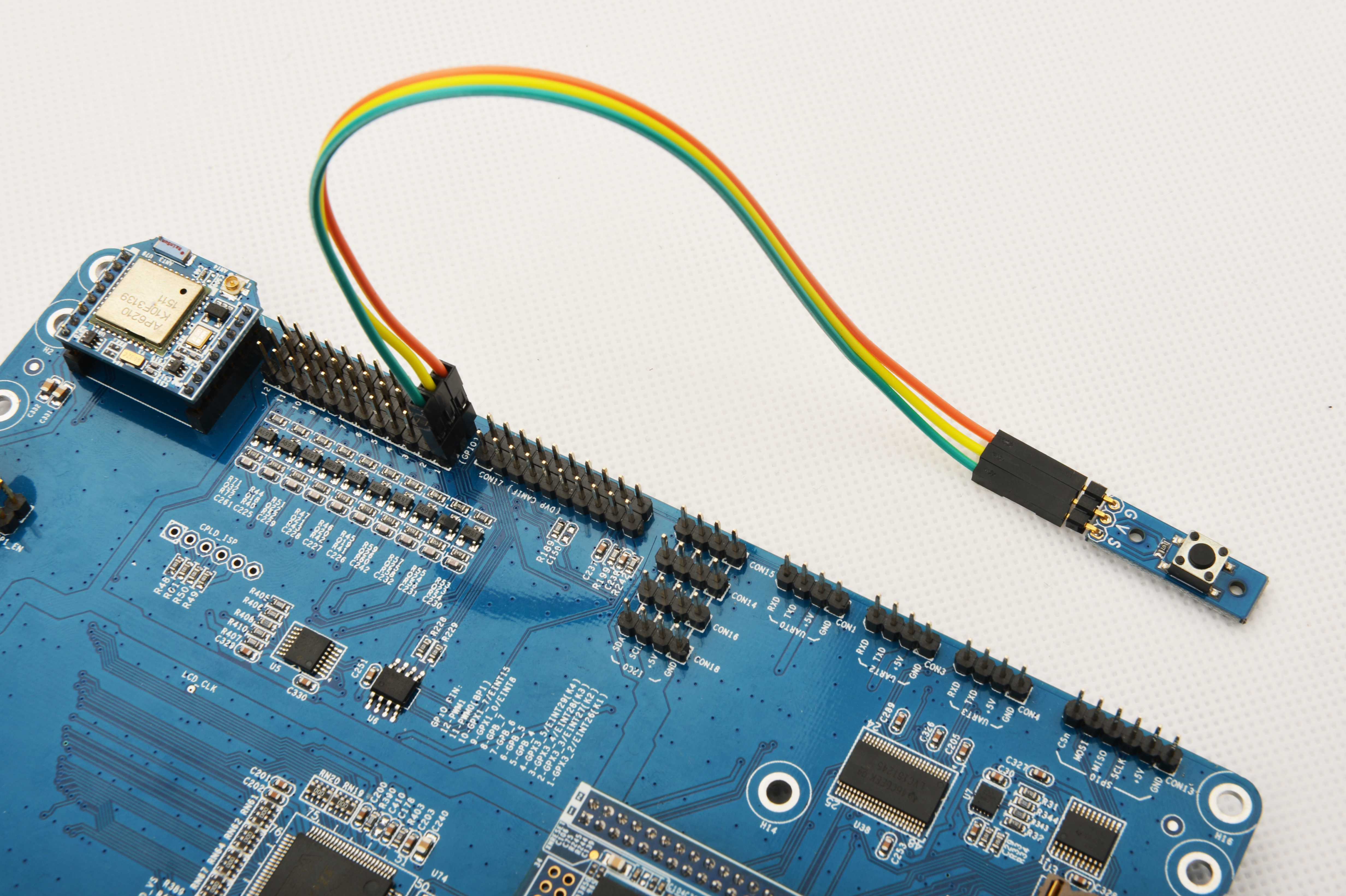
连接说明:
| Matrix-Button | Tiny4412 |
| S | GPIO1 S |
| V | GPIO1 5V |
| G | GPIO1 GND |
7.3 编译测试程序
进入Matrix代码仓库,切换到tiny4412分支
$ cd matrix $ git checkout tiny4412
编译Matrix配件代码
$ make CROSS_COMPILE=arm-linux-gnueabihf- clean $ make CROSS_COMPILE=arm-linux-gnueabihf- $ make CROSS_COMPILE=arm-linux-gnueabihf- install
注意:请确保你的主机PC当前使用的交叉编译器为Tiny4412-UbuntuCore配套的arm-linux-gnueabihf-gcc-4.7.3。
编译出来的库文件位于install/lib目录下,而测试程序则位于install/usr/bin目录下,模块Matrix-Button对应的测试程序为matrix-button。
7.4 运行测试程序
将带有UbuntuCore系统的SD卡插入一台运行Linux的电脑,可以挂载SD卡上的boot和rootfs分区。
假设rootfs分区的挂载路径为/media/rootfs,执行以下命令可将Matrix的所有库文件和测试程序拷贝到Tiny4412的文件系统上。
$ cp install/usr/bin/* /media/rootfs/usr/bin/ $ cp install/lib/* /media/rootfs/lib/ -d
将SD卡重新插入Tiny4412,上电启动,在UbuntuCore的shell终端中执行以下命令运行模块Matrix-Button的测试程序。
$ matrix-button注意:此模块并不支持热插拔,启动系统前需要确保硬件连接正确。
7.5 代码展示
int main(int argc, char ** argv) { int i; int retSize = -1; char value[ARRAY_SIZE(button)]; int devFD = -1; printf("Using pin GPIO_PIN1\n"); if ((devFD =sensorInit(button, ARRAY_SIZE(button))) == -1) { printf("Fail to init sensor\n"); return -1; } printf("Press the button...\n"); if ((retSize = sensorRead(devFD, value, ARRAY_SIZE(button))) == -1) { printf("Fail to read sensors\n"); } if (retSize > 0) { i = 0; for (i=0; i<retSize; i++) { printf("Button[%d]:%d\n", i, value[i]); } } sensorDeinit(devFD); return 0; }
